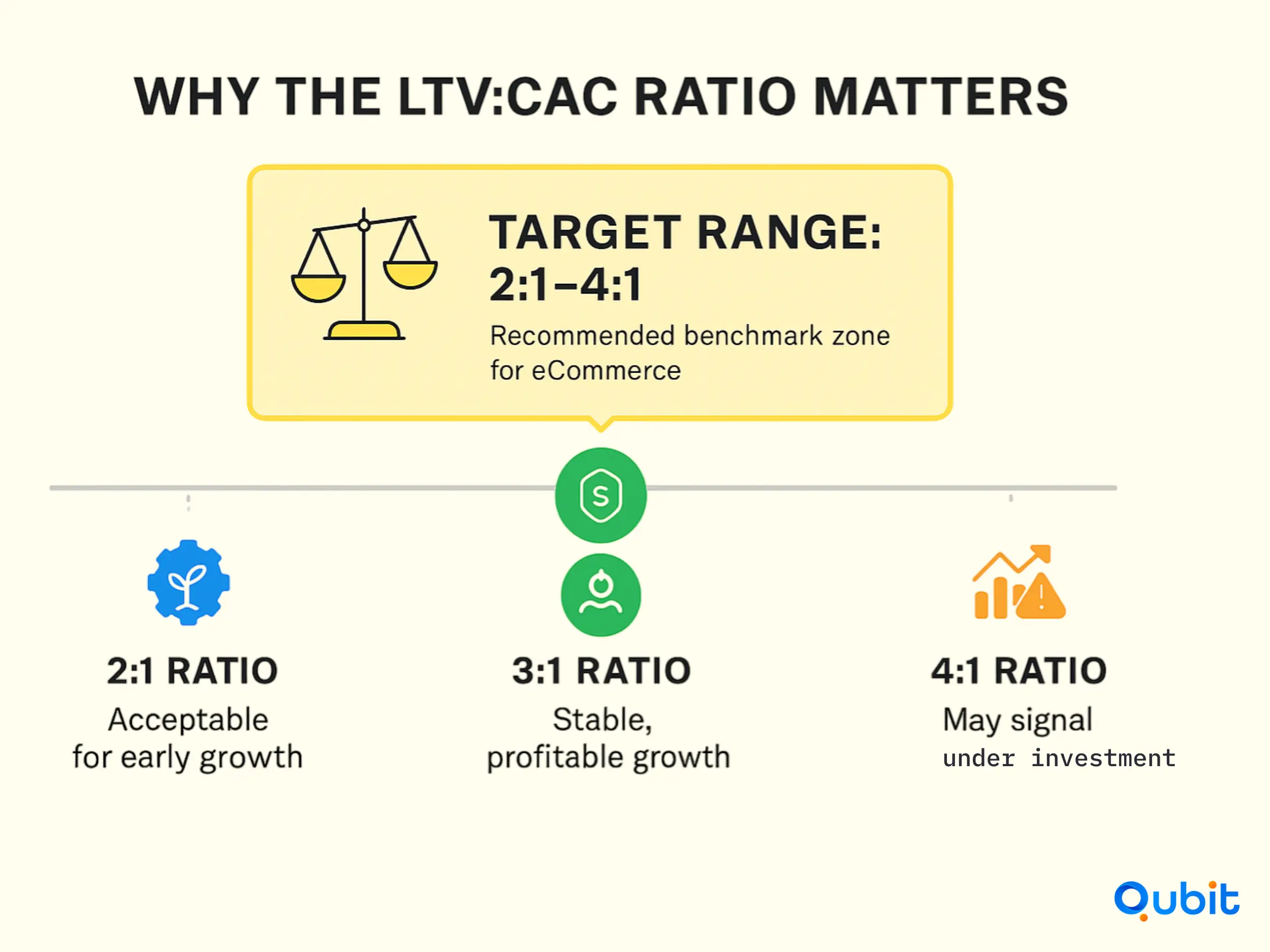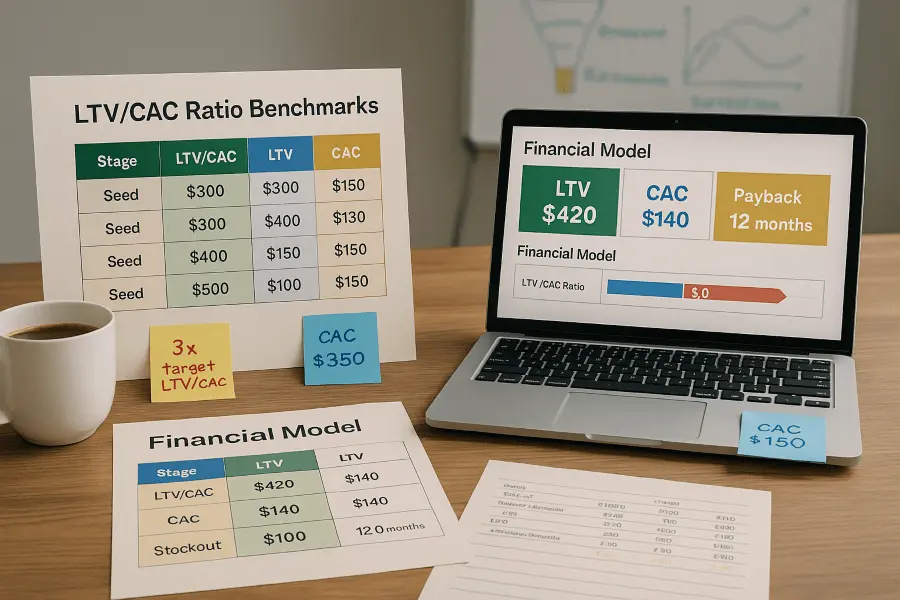Investors often scrutinize the Lifetime Value (LTV) to Customer Acquisition Cost (CAC) ratio as a key metric to assess profitability and scalability. A strong LTV/CAC ratio not only reflects efficient customer acquisition but also signals long-term growth potential.
For e-commerce startups, achieving an optimal ratio—typically around 3:1—can significantly enhance their appeal to investors during seed rounds. An examination of industry funding approaches appears in ecommerce startup fundraising strategies, offering you insights that align with the broader financial context for e-commerce start-ups.
This blog explores actionable benchmarks and strategies tailored to seed-stage e-commerce businesses, helping founders optimize their metrics and secure the funding they need.
LTV:CAC Ratio
The LTV:CAC ratio serves as a critical metric for evaluating the profitability and sustainability of customer acquisition strategies. Lifetime Value (LTV) quantifies the total revenue a customer generates over their relationship with a business, while Customer Acquisition Cost (CAC) measures the expense incurred to acquire that customer. Together, these metrics provide insights into whether a company is efficiently converting acquisition efforts into long-term profitability.
Why the LTV:CAC Ratio Matters

A balanced LTV:CAC ratio is essential for sustainable growth. Industry benchmarks suggest that a ratio of approximately 3:1 is ideal for eCommerce businesses, indicating that the revenue generated by a customer is three times the cost of acquiring them. However, ratios within the range of 2:1 to 4:1 are still considered healthy, depending on scalability and operational efficiency.
For businesses aiming to optimize their LTV:CAC ratio, understanding how to calculate Lifetime Value is crucial. General guidance on calculating LTV with a recommended ratio of at least 3:1 for eCommerce can provide actionable insights into improving profitability.
Interpreting the Ratio
- 3:1 Ratio: Often regarded as the gold standard, this ratio signifies stable and profitable growth. It ensures that acquisition costs are justified by the revenue generated over time.
- 2:1 Ratio: While lower, this ratio may still be acceptable for businesses in early growth stages or those prioritizing scalability over immediate profitability.
- 4:1 Ratio or Higher: While seemingly advantageous, excessively high ratios could indicate underinvestment in customer acquisition, potentially limiting growth opportunities.
Understanding and maintaining an optimal LTV:CAC ratio is vital for eCommerce businesses striving for long-term success.
Factors Impacting LTV and CAC
Understanding the dynamics behind Lifetime Value (LTV) and Customer Acquisition Cost (CAC) is essential for businesses aiming to optimize profitability. While LTV reflects the revenue potential of a customer over their lifetime, CAC measures the cost of acquiring that customer. Both metrics are influenced by distinct factors that businesses must carefully manage to strike the right balance.
Elements Driving LTV Growth
Several factors contribute to increasing LTV, making it a cornerstone of sustainable business growth:
- Purchase Frequency: Customers who buy more often significantly boost LTV. Encouraging repeat purchases through loyalty programs or personalized offers can amplify this metric.
- Recurring Revenue Models: Subscription-based businesses inherently benefit from predictable income streams, which elevate LTV. These models foster long-term customer relationships and reduce churn.
- Customer Retention: Retaining customers is more cost-effective than acquiring new ones. High retention rates, achieved through excellent customer service and engagement strategies, directly enhance LTV.
Factors Elevating CAC
On the other hand, CAC is shaped by the costs associated with acquiring new customers:
- Marketing Expenditures: Rising ad competition and market saturation are driving up costs, as highlighted in the trend of Increasing customer acquisition costs in the current market. Businesses must carefully allocate budgets to avoid overspending while maintaining effectiveness.
- Support and Production Costs: The resources required to onboard and serve new customers can inflate CAC, especially if operational inefficiencies exist.
- Acquisition Efforts: From paid ads to influencer collaborations, acquisition strategies often demand significant investment. Balancing these efforts with ROI is critical to keeping CAC in check.
Balancing LTV and CAC for Profitability
Achieving a favorable LTV-to-CAC ratio is key to long-term success. Businesses that optimize LTV while controlling CAC can improve their profitability and attract investor interest. For a deeper dive into how aligning these metrics can prepare your e-commerce startup for investment, explore how broader discussions enrich your understanding of investment readiness as prepare ecommerce startup for investment delineates how aligning business models with investor benchmarks shapes funding potential.
By understanding these factors and their interplay, businesses can refine their strategies to maximize LTV and minimize CAC, ensuring sustainable growth and profitability.
Prioritizing Target Audiences
Understanding who your ideal customers are is the cornerstone of effective marketing. By focusing on the right target audiences, businesses can create campaigns that resonate deeply, driving engagement and optimizing key metrics like customer acquisition cost (CAC) and lifetime value (LTV).
Why Target Audience Prioritization Matters
Not all customers are created equal. Identifying high-value segments ensures that marketing resources are allocated efficiently, maximizing returns. For example, in ecommerce, tailoring campaigns to specific audience groups can significantly enhance LTV, as personalized messaging often leads to repeat purchases and stronger brand loyalty.
Steps to Prioritize Your Target Audiences
Segment Your Audience
Break your customer base into distinct groups based on demographics, behaviors, and preferences. This segmentation allows for more precise targeting, ensuring that each campaign speaks directly to the needs of its intended audience.Analyze Customer Data
Dive into analytics to uncover patterns in purchasing behavior, engagement rates, and retention metrics. These insights can help pinpoint which segments are most profitable and worth prioritizing.Create Tailored Campaigns
Develop marketing strategies that align with the unique characteristics of each audience segment. Whether it’s personalized email campaigns or targeted social media ads, customization is key to boosting engagement and driving conversions.
Benefits of Targeted Campaigns
Prioritizing target audiences doesn’t just improve marketing efficiency—it also has a direct impact on financial metrics. For instance, businesses that focus on high-value segments often see a reduction in CAC, as they’re spending less to acquire customers who are more likely to convert. Additionally, targeted campaigns can increase LTV in ecommerce by fostering stronger relationships with customers who feel understood and valued.
By honing in on the right audiences, businesses can achieve a balance between cost-effectiveness and long-term growth, ensuring sustainable success.
Average CAC for eCommerce Companies by Industry
Customer acquisition cost (CAC) benchmarks vary significantly across eCommerce industries, highlighting the importance of tailored strategies for financial success. Understanding these differences is crucial for businesses aiming to optimize their unit economics and achieve sustainable growth.
Industry-Specific CAC Insights
The average CAC for eCommerce companies depends heavily on the industry they operate in. For instance, fashion and apparel brands often face higher CAC due to intense competition and the need for visually appealing marketing campaigns. On the other hand, niche industries like eco-friendly products or specialty food items may experience lower CAC, as their audiences are more targeted and easier to engage.
Connecting CAC Benchmarks to Financial Performance
Analyzing CAC benchmarks alongside unit economics provides a clearer picture of profitability. A thorough breakdown of key performance indicators unfolds in ecommerce unit economics financial model, presenting you with a detailed look at the metrics that underpin profitability. By linking CAC data with metrics like customer lifetime value (CLV) and gross margin, businesses can identify whether their acquisition costs align with their long-term financial goals.
Why Industry-Specific Strategies Matter
Generic approaches to reducing CAC often fail to account for the nuances of different industries. For example, a subscription-based eCommerce company might focus on retention strategies to offset high upfront CAC, while a direct-to-consumer brand may prioritize influencer partnerships to drive cost-effective conversions.
Getting Help Lowering eCommerce CACs
Reducing customer acquisition costs (CACs) in eCommerce often requires more than just internal efforts. Collaborating with external professionals can provide the expertise needed to implement strategies that are both effective and sustainable. These experts bring specialized knowledge to address challenges in execution, ensuring that your business achieves measurable results in cost reduction.
One key advantage of seeking external help is the ability to align CAC benchmarks with broader operational goals. For example, insights into operational efficiency and investor evaluations merge within inventory metrics ecommerce investors, framing a discussion that connects inventory practices with funding assessments. This synergy between inventory management and CAC reduction can create a cohesive strategy that appeals to stakeholders while optimizing internal processes.
Additionally, external professionals often have access to advanced tools and industry insights that can streamline customer acquisition efforts. Their expertise can help identify inefficiencies, refine targeting strategies, and optimize ad spend—all critical components for lowering CACs effectively.
By partnering with specialists, eCommerce businesses can overcome execution barriers and focus on scaling efficiently. Whether it's through refining marketing campaigns or improving operational workflows, external expertise can be the catalyst for achieving lower CACs and driving sustainable growth.
Conclusion
Achieving a successful e-commerce seed round requires a strategic approach rooted in understanding key metrics and applying actionable insights. By mastering the LTV:CAC ratio, pinpointing the factors that influence profitability, and implementing targeted optimization techniques, businesses can position themselves for sustainable growth.
Data-driven decisions are the cornerstone of profitable fundraising. They empower startups to refine their strategies, minimize risks, and maximize returns. With the right insights, businesses can confidently approach investors, demonstrating their potential for long-term success.
If you're ready to secure the funding your business deserves, we at Qubit Capital are here to support you every step of the way with our Fundraising Assistance service. Let’s get started.
Key Takeaways
- Understanding unit economics is crucial for gauging profitability in e-commerce.
- Accurate analysis involves both item-level and customer-level metrics.
- Advanced approaches like predictive and flexible LTV models can refine financial planning.
- Value-based pricing is a more sustainable alternative to heavy discounting.
- Integrating unit economics with targeted email marketing enhances investor readiness.
Frequently asked Questions
How do you calculate CAC benchmarks?
CAC benchmarks are calculated by dividing the total cost of customer acquisition by the number of new customers acquired, with industry averages used for comparison.


 Back
Back



